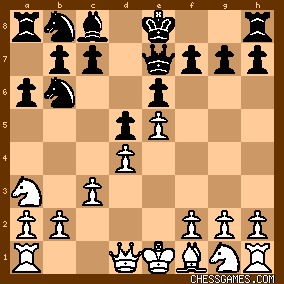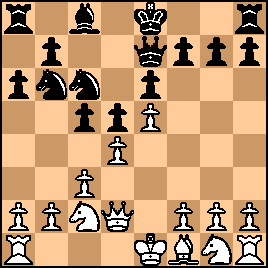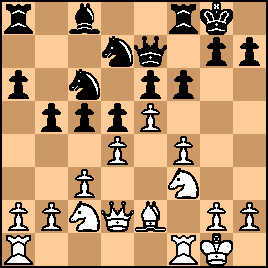| KEG: A game shaping up to be an engrossing struggle, with Wolf eyeing the King-side while von Scheve attempted a whole-sale pawn advance on the other wing that came to a crashing halt when von Scheve began to lose the thread of the game on or about move 22 and then miscalculated with his blunder on move 26. The game ended shortly thereafter when von Scheve recognized belatingly that the pin on which he had staked his fortunes did not have the effect he had expected and that it was he and not Wolf who faced a back-rank mate. 1. e4 e6
2.d4 d5
3. Nc3 Nf6
The Classical French was far more popular than 3...Bb4 back in 1902. 4. Bg5 Be7
5. e5 Nfd7
6. BxB
The heyday of 6.. h4, later called the "Alekhine-Chatard Attack." though known in 1902, still lay in the future. The text is fine is White is prepared to settle for a small advantage without yet committing to an all-out King's side attack. 6... QxB

click for larger view7. Nb5?
7. f4 is most usual and probably best here. But the text was popularized first by Alapin about 15 moves before this game, was tried several times by Charousek, and was later utilized by Marozcy a few times, most recently in his 6th round win over Reggio at this tournament (see my notes on the opening in that game on this site). It later became a pet line of Rudolph Spielmann. 7... Nb6
As played by Reggio in the earlier game. Reggio (playing White) had defeated Mason after he adopted the text at Monte Carlo 1901 (and was unfairly criticized for not playing the supposedly stronger 7...Qd8). In fact, as I noted in my notes on Reggio-Mason, both move are fine. Ironically, Reggio, having won as White in this position after Mason played 7...Nb7, then played the same move against Maroczy at Monte Carlo 1902. Despite the earlier results, von Scheve decided to try the text and came out of the opening in decent shape. 8. c3
As played in the earlier games by Maroczy and Reggio. Indeed, one of the ideas of 7. Nb5 is to allow White to buttress his center with 8. c3. 8... a6
The best way to attempt to punish the early venture by the White Knight on b5. 9. Na3

click for larger view9... c5
Mason played 9...f5?! in his loss to Reggio at Monte Carlo 1901. Reggio played the more solid 9...f6 against Maroczy in the above-mentioned 6th round game against Maroczy and was followed in this regard by Rodolf Spielmann. The text, however, later became considered best. It was most notably featured in Lilienthal's win as Black against Emanuel Lasker at Moscow 1936. 10. Qd2
Lasker played 10. Nc2 in his game against Lilienthal at Moscow 1936 and got a decent position, losing only because of later mistakes. Lasker's move, as well as 10. f4 and 10. Qd2 as played by Wolf here are all reasonable choices. 10... Nc6
11. Nc2
Trying to find a way to get this Knight back in the game makes sense, but arguably 11. f4 was best. 
click for larger view11... Nd7
Perhaps already planning a Queen-side storm. But simplest and probably most prudent were 11...cxd4 or 11...f6. 12. f4
Beginning here the game became quite interesting; the players each locking in on attacking on one side of the board. In these sorts of struggles, the superior tactical player generally finds a way to win, as occurred here. The prepares to bring White's g1 Knight into the intended King-side attack. 12... b5
Staking out his area for attack: the Queen-side. 13. Nf3
All according to plan.
13... f6
While hardly a blunder, the text played into Wolf's concept by creating a King-side weakness. 15. Be2 0-0
15. 0-0

click for larger view | 




